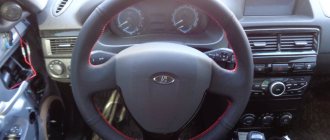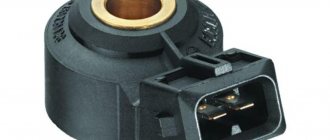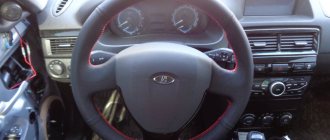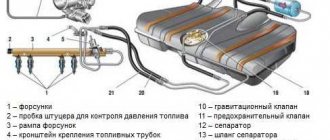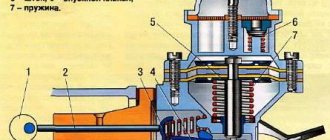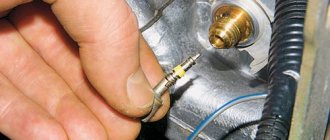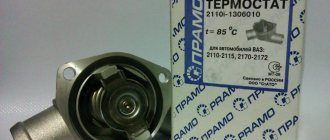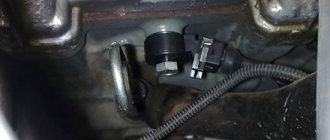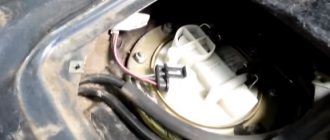In a situation where the fuel pump on a Lada Priora car does not work, the causes of the problem are not so difficult to detect. But if a problem occurs somewhere along the road, then without fixing the problem you will not be able to continue your journey and you will have to look for a way to tow the car to the nearest service station. But not all faults related to the fuel supply are fatal; some of them can be detected and eliminated independently.
The fuel pump does not work on the Lada Priora: reasons
In a situation where the fuel pump on a Lada Priora car does not work, the causes of the problem are not so difficult to detect. But if a problem occurs somewhere along the road, then without fixing the problem you will not be able to continue your journey and you will have to look for a way to tow the car to the nearest service station. But not all faults related to the fuel supply are fatal; some of them can be detected and eliminated independently.
Where is the fuel pump located
The Priora fuel pump is located in the fuel tank. It is accessible under the rear seat of the car. When you remove the seat, you can find a hatch underneath it, which is secured with two screws. After unscrewing the screws and dismantling the cover, you can see the upper part of the fuel pump glass. The glass is attached to the tank with nuts through a metal ring and a rubber gasket, on 8 studs.
The fuel pump glass has:
- Fuel pressure control;
- Fuel pump;
- Fuel level sensor;
- Coarse fuel filter;
- Sump (bucket);
Location and operation of the fuel pump
The fuel pump in the Lada Priora car operates from an electric drive, which is turned on after turning the key to the ignition position. Within a few seconds, it pumps fuel into the fuel system so that the pressure in it reaches 3.7 bar, while a characteristic low buzzing sound is heard inside the cabin. When the pressure mark is reached, you can start the engine.
The unit works continuously, just because of the noise of the motor, the sound made by the pump is no longer audible. A special RTD regulator with a bypass valve maintains the required pressure in the fuel line.
The whirring of the fuel pump can be heard inside the car because it is located inside the fuel tank, located under the rear seat of the Priora. There is also a built-in fuel coarse strainer and a level sensor with a float. Gasoline pumped by the pump is supplied to the injectors through a fuel line tube made of thick-walled copper tube.
Life hack: Priora fuel pump - price, how to check and change
The Priora fuel pump ensures continuous movement of gasoline to the injector. Only after the engine receives a sufficient amount of fuel will it be able to start and then work, clearly performing its functions.
Lack of gasoline will lead to the worst consequences. The gas pump of a Priora car is a bucket with a motor and hoses, it is located under the back seat, near the gas tank. The price is multi-part, since the system consists of many spare parts: Relay, motor, fuse, hoses and other parts. There should be a pressure of 3.6–4.0 bar in the fuel system (rail, fuel pump). If it is different, the system will not work as expected. The price of only a fuel pump for a Priora car starts from 2000 rubles. Agree, that’s not enough for a bucket :). The assembled fuel pump will cost from 3,500 rubles. Look at the photo below of the fuel pump assembly.
There is no sound when turning the key, which means the fuel pump is not working. There may be several reasons for this: even the fuse may be involved in the malfunction - read the article to the end and find out all the system malfunctions.
Symptoms of unit malfunction
Malfunctions of the Priora fuel supply pump can manifest themselves in different ways.
Sometimes it fails completely, in other cases it maintains too low pressure in the system. Symptoms of problems are:
- after turning the key in the ignition switch, the characteristic sound of the fuel pump is absent, and the engine does not start;
- when the ignition is turned on, the pump pumps, the power unit starts, but when you try to move away, the engine stalls and starts with difficulty;
- The car jerks while driving, stalls and does not want to start.
The first symptom indicates a malfunction in the electrical circuit that supplies power to the unit. Also, a complete failure may be the result of a breakdown of the pumping device itself, and it has to be replaced. Fortunately, such breakdowns are quite rare. Electric fuel pumps installed on VAZ cars are considered quite reliable devices and operate without problems for 150-200 thousand km.
The remaining 2 symptoms indicate that the amount of fuel supplied to the injectors is not enough for normal driving. If the car somehow starts and idles, then there is no longer enough fuel to move. Since the characteristic symptoms of low pressure in the line are similar to the symptoms of problems with other units and systems, it is necessary to carry out diagnostics and more accurately determine the cause.
Standard fuel pump for Priora - article number and price
The components catalog for Priora calls the entire system “Fuel Supply System”. It consists of several parts:
- Front tube for flammable substances 1119-01104013-00 - about 250 rubles.
- Front hose 2110-11104218-00 – 600 rubles.
- Fuel filter tube 2110-1110422205 – 800 rub.
- Gasoline pipe 2110-11104056-00, price - 400 rubles.
Pipelines: they are connected directly to a flat container - the gas tank - and then extend from it towards the engine.
Vapor recovery system
- Canister purge valve 2170-01164042-00, price - 1,200 rubles.
- Hose 90 cm long 2110-31164109-10 – 450 rubles.
- Steam pipe 2170-01164084-00 – 120 rubles.
- Middle steam pipe 2170-0116424800 – 600 rubles.
- Front steam pipe 2170-01164244-02 – 200 rubles.
- Adsorber tube 2170-01164282-02 – 350 rub.
- Adsorber 2170-01164010-01 – 750 rub.
- Separator 2170-01164005-02 – 1700 rub.
- Ramp assembly 118-01144010-00, price – 10,000 rubles.
- O-ring 2112-01104252-00, price – 400 rubles.
- Nozzle (one) 1118-01132010-00, price – 1500 rubles.
Finally, the most important thing is the fuel pump system unit for Priora (16 valves), manufactured by Bosch: 2110-11139009-00, price - from 2,000 rubles, its service life is up to 200,000 km. Fuel pump filter for a Priora car - 1118-11392-00, price - 50 rubles.
Diagnosis and Troubleshooting
It is relatively simple to verify that the electrical network is faulty - this can be done without removing the fuel pump. When the sound of its operation is not heard when the ignition is turned on, you must immediately check the fuse responsible for this circuit. It is installed in a block mounted at the bottom in front of the front passenger seat. You need to remove the block cover, find the fuse marked F3, rated for 15 A, and replace it. This kind of work can be done on the road.
If the operation of the fuel pump has not resumed, you should switch your attention to relay K2, located in the same block. It closes the power circuit of the pumping device based on a signal from the controller. You can also check the serviceability of the relay in road conditions, for which you will need a piece of copper wire. Diagnostics are carried out in the following order:
- Remove relay K2 from the connector.
- Turn on the ignition.
- Using a wire, connect the contacts marked “30” and “87”; the numbers are marked on the relay. Another option is to apply power to pin “11” located in the diagnostic connector. The +12 V voltage can be taken nearby, from the cigarette lighter.
- If you hear the pump humming, then you need to change relay K2.
If after the above manipulations the unit is still “silent”, it is necessary to check the integrity of the wiring and the reliability of the contact at the place of its connection. This will require a device, so it will not be possible to carry out such work in the middle of a field. Unless you can check the serviceability of the fuel pump itself by disconnecting the connectors from it and supplying 12 V directly from any convenient source. If the pump still does not hum, it should be replaced.
Be careful when connecting wires directly and make sure that there are no drops of gasoline nearby, as a spark may cause it to ignite.
It will not be possible to diagnose insufficient fuel supply to the injectors under road conditions, unless you carry a pressure gauge with a corresponding hose for connection to the fuel rail. The amount of gasoline supplied is characterized by the pressure in the network, to measure which you will need a pressure gauge. The check is performed as follows:
- Twist off the plastic cap covering the diagnostic fitting. It is located at the end of the fuel rail and is a regular spool.
- Press the spool rod to release the pressure in the line. In case of gasoline leakage, place a small container under the spool. Perhaps the malfunction will make itself felt already at this stage if there is no pressure in the network and no fuel flows from the fitting.
- Unscrew the spool and put the hose from the pressure gauge onto the fitting. With the ignition off, apply 12 V directly to the pump. To clearly record the readings, it must work for at least 10 seconds.
If the pressure is below 3.6 bar, you must first change the coarse filter. If this does not help, then you will have to check the RTD and the tightness of the injectors. This is the only way to accurately determine the source of the problem.
Source
Fuel pump for injection engine
With the advent of the injection engine, the need for a mechanical element disappeared. It did not produce the required pressure in the system. Therefore, an electric fuel pump was developed, located directly in the fuel tank.
As the name suggests, this type of element operates using electricity. It consists of a filter and a housing. The latter contains a diaphragm with discharge and suction valves. An electromagnetic valve is located under the diaphragm. The fuel system of an injection car is more complicated than a carburetor due to the presence of an additional pressure regulator, which, when sufficient pressure is created in the fuel rail - 2.8-3.2 kilopascals, turns off the supply of electricity to the fuel pump.
Checking the fuel pump Lada Kalina/Granta
If after turning the ignition key there is no buzzing sound from the fuel pump, then the first thing to check is the fuel pump fuse and relay. In the Lada Kalina and Lada Granta mounting block, the fuel pump fuse is F21 (15A), and the fuel pump relay is K12. If the fuse is good, do the following:
- Turn on the ignition
- Remove the fuel pump relay
- Apply +12V to pin No. 11 of the diagnostic block, or place a jumper between 87 and 30 relay pins
- Check by ear that the fuel pump is turned on
If the fuel pump does not turn off, then check:
- Wiring and contacts between the fuel pump and the diagnostic block/fuel pump relay. To do this, check the voltage at the fuel pump chip using a test lamp or multimeter.
- There is no connection between the fuel pump and the vehicle ground. Apply the mixture to the fuel pump (located under the rear seat).
- The fuel pump is faulty. To check it, apply +12V directly to the contacts of the fuel pump (Attention! Remaining gasoline may ignite from a spark!).
In rare cases, the fuel pump does not work due to:
- ECU (controller) malfunction
- alarm malfunctions
Price
Below are the prices and part numbers for the fuel pump, depending on the manufacturer.
| Manufacturer | vendor code | Price, (rubles) |
| Bosch | 2112-1139009 | 2000 |
| SOATE | 60.1139-01 | 1100 |
| RES | 0588455055 | 900 |
The table below shows the elements of the fuel cup and their prices, taking into account the manufacturer.
| Detail | vendor code | Price, (rubles) |
| RTD | 11180-1160010-00 | 480 |
| Hose | 21083-113902200 | 30 |
| Mesh | 21101-113920000 | 30 |
| The cost of a complete fuel pump glass starts from 2,400 rubles. Article: 21101-1139009 |
Checking the fuel pump Lada Priora
On the Lada Priora, the fuel pump relay and its fuse are located in an additional mounting block near the left foot of the front passenger. The fuse is marked F3 (15A), and the relay is K2.
First of all, we check the fuel pump fuse, and if necessary, replace it with a similar new one. We check the wiring and the fuel pump itself in the same way as on Lada Kalina and Lada Granta cars (see above).
As a reminder, don't forget to change your fuel filter regularly.
Source
Priora fuel pump fuse
The Priora fuel pump fuse is not located in the standard location for all fuses. It is located at the front passenger's feet, under the footwell air duct cover.
The red oval shows the fuel pump fuse
Rated current of this fuse = 15A, number F3;
It is strictly prohibited to install fuses with a rating higher than specified.
Why the Lada Priora fuel pump does not pump and what to do
What to do if the fuel pump of the Lada Priora has stopped pumping: reasons, solutions
If the pump stops working properly or works every once in a while, as a rule, the engine does not start (16 valves). This happens for the following reasons:
- tank fuse blown;
- tank relay is faulty;
- the gas tank itself is faulty;
- problems with wiring and adjacent contacts;
- problem with the controller;
- problems with the alarm system, etc.
Reasons for the fuel pump not pumping
Quite often it happens that the Priora fuel pump simply stops pumping fuel. There are many reasons for this problem, but in order to find them you need to understand what can affect the performance of the fuel pump. Below are all the reasons why the pump may stop pumping fuel into the system.
Fuse
It often happens that the fuse blows under load and breaks the power supply circuit to the fuel pump. As a result, the fuel pump cannot work. The fuse needs to be checked.
The relay is directly responsible for the operation of the fuel pump, thereby turning off the operation of the pump if it fails. It happens that the contacts on the relay oxidize or the coil burns out, which leads to the pump stopping and the inability to pump pressure into the system.
Filter
Fuel filters, fine and coarse filters are clogged. They need to be checked, or at best replaced.
Gasoline pump
It is also possible that the fuel pump itself may fail. Due to aging or poor quality fuel. You can read how to check the fuel pump in our article.
The fuel pump does not work on the Lada Priora
On the Lada Priora passenger car, as on other cars with an injection engine, the operating algorithm of the electric fuel pump is as follows:
- as soon as the driver turns on the ignition, he should hear within 3-4 seconds the noise of the fuel pump starting, which raises the gasoline pressure in the fuel rail so that the engine can start normally;
— after the pressure in the fuel rail rises, the fuel pump turns off;
— next, the driver turns the ignition key to the “starter” position, as a result of which the engine crankshaft begins to rotate and the crankshaft position sensor (CPS) is immediately activated, the pulses of which go to the electronic control unit (ECU);
— The ECU, in turn, turns on the relay, when the contacts of which are closed, voltage is supplied to the terminals of the fuel pump and if it is working properly, it will begin to perform its function, which is to supply gasoline from the tank to the fuel rail;
— and if the crankshaft stops rotating, the DPKV will stop sending pulses to the ECU, which will de-energize the relay, its contacts will open and the fuel pump will stop working;
Knowing this algorithm, it is much easier for the driver to find a malfunction as a result of which the fuel pump refuses to work. But it is worth adding that all electrical circuits are protected by fuses and troubleshooting usually begins with checking them. Considering that there are two options for turning on the fuel pump: the ignition key in the “ignition on” position and the ignition key in the “starter” position. Then you will have to check two fuses, which are located in the side of the tunnel on the front passenger side.
When the ignition is turned on, electric current from the battery flows through fuse F1 (15 A) into the circuit of the main relay K1, which supplies plus to the coil of the fuel pump relay, as a result of which its contacts are closed and voltage is supplied to the terminals of the fuel pump. After a few seconds, the controller, having collected the necessary information, turns off the main relay, and since the electric current went to the fuel pump through it, the fuel pump naturally turns off. And when the ignition key is turned to the “starter” position, the electric current from the battery flows through fuse F3 (15 A), and the fuel pump relay K2 turns on the ECU, according to the DCPV signal. That is why the driver needs to check both fuses.
If at least one of the above devices fails, even a working fuel pump will not work. You can check the condition of the fuel pump itself by applying voltage to its terminals directly from the battery.
Share this article with your friends:
How to remove and change the fuel pump on a Priora
To remove the fuel pump on a Priora car, you will have to do a lot of preparation. Since the system is quite complex, when dismantling it you will have to interact with many parts of the machine. You should start by disconnecting the negative terminal from the battery. Replacing the device for supplying fuel to the engine is carried out as part of dismantling the fuel module:
- Open the back door. Look under the sofa cushion for plastic plugs. Remove them by pressing lightly. You will see the sofa fasteners.
- Unscrew the nut with a “10” socket wrench.
- Pull the fastener towards you. Do the same action on the other side.
- Pull out the sofa cushion.
- If necessary, remove the backrests, although they will not interfere much.
- Place a basin or other container on the floor of the body.
- Find a black square metal hatch that is covered with sound insulation. Fold back the fabric and begin dismantling the hatch.
- Use a Phillips screwdriver to unscrew the screws. Remove the hatch.
- You will see the top of the fuel module and some wires on top of it. Press the latch that holds the harness and disconnect the wires from the module. There are also two small hoses connected to the fuel supply system cover. One is responsible for supplying gasoline, the other for shipping.
- Hold the hose directly near the place where it is attached to the module, and then turn it until you see the green inserts on top - these are the clamps. Clamping them, pull the hose towards you. Drain the fuel into a container.
- Unscrew the fastening nuts that hold the pressure plate using a “10” socket wrench. Remove the pressure plate.
- Now comes the careful process of dismantling the module. Please note that in the immediate vicinity there is a part of the fuel sensor that should not be touched. Therefore, when removing the fuel supply system assembly, try to make your movements as smooth as possible.
- Immediately point the module over the container - gasoline will drain from it.
Next, in order to release the fuel module, do the following:
- Disconnect the negative wire from the fuel pressure regulator. Disconnect the harness by pressing the latch.
- Disconnect the wires from the pump.
- Press out the clamps that hold the fuel sensor in one position.
- Slide the flammable substance sensor along the grooves and then remove it.
Before replacing, you should check the fuel supply system assembly.
How to check the fuel pump on a Priora car
According to AvtoVAZ, a standard pump for a VAZ-2170 should pump 60 liters of gasoline per hour. To check it on your car, do the following:
- Turn the key in the lock, turning on the ignition.
- Remove the fuel pump relay using a gentle movement.
- Place a jumper between pins 30 and 87.
- Listen for the familiar sound of fuel pumping. If you hear that pumping is proceeding normally, you can turn the key back. To “fix” the car, change the fuse.
If the engine fuel supply does not stop, do the following:
- Check the voltage at the pump connector using a multimeter.
- Check the ground supply to the pump chip.
- Clean the fuel module from gasoline (it’s even worth wiping it with a rag!), then apply +12 V to it. This is a “direct” test of its performance.
Signs of fuel pump malfunctions
The main symptoms of fuel pump failure, as well as malfunctions in its operation, are:
- the car starts with difficulty, the engine runs unstable, there are dips, jerking when pressing the gas pedal, etc.;
- the pump does not pump after turning on the ignition, does not turn the starter and does not pump the fuel pump, the engine does not start;
There have also been cases when the fuel pump stops pumping while driving. In such a situation, the engine begins to malfunction and stalls immediately after the remaining gasoline in the fuel line is used up. The problem can occur either regularly or periodically.
Gasoline pump
The Priora fuel pump is a kind of electric DC motor in the form of a cylinder. Inside the pump there is a shaft on which an impeller is rigidly mounted that pumps fuel into the system and a check valve that does not allow the fuel to lose pressure in the system after the pump stops.
The operating pressure in the system that the pump must maintain is in the range of 3.6-4.0 bar. If there is a loss of pressure in the system, the engine will operate unstably, losing speed and detonating.
The fuel pump cannot work alone, so it is part of the fuel cup of the fuel pump. This glass contains all the necessary elements for pressurizing the fuel system.
The fuel pump capacity according to the manufacturer’s requests is from 60 l/h.
The fuel pump does not pump: causes and diagnostics
Let's start with the fact that if the gas tank is full, the battery is charged, the spark plugs are dry and there is a spark, the starter turns the engine normally, but the engine does not seize, then you should pay attention to the gas pump. A common problem is that there is no power to the fuel pump after the ignition is turned on. In a similar way, the malfunction manifests itself in motion, when the power to the fuel pump is lost and the engine suddenly stalls.
An equally important point is how much the fuel pump pumps. In other words, the pump may hum and buzz (power is being supplied), but not create the required pressure in the fuel line. The pressure in the fuel system with a working fuel pump must be more than 3 bar (which depends on the specific car model). The indicated pressure is accumulated in the fuel rail and has an indicator of 300 kPa and above.
To check, you need to measure the pressure in the fuel rail with a pressure gauge, taking into account the indicators that are the norm for a specific car model. Using the example of injection VAZs, the pressure when the ignition is turned on is 3 atmospheres, at idle the figure is 2.5 atmospheres, when you press the gas 2.5-3 atmospheres. This method will help you accurately determine:
- malfunction of the fuel pressure regulator in the rail;
- breakdown of the fuel pump or a noticeable decrease in its performance due to wear;
- severe contamination of filters (fuel filter and/or fuel pump mesh);
In the second case, when you press the gas, the pressure does not increase; in the latter case, the pressure gauge needle rises, but very slowly or jerkily.
A decrease in pressure below the norm will lead to the fact that the engine may not start or start with difficulty, stall, jerk, operate unstably and with failures. If this happens due to the fault of the pump and not the fuel filter, then there is a high probability that the coarse filter screen of the fuel pump is clogged. In this case, there is no need to change the fuel pump itself, since it will be enough to replace or even clean the mesh.
If you suspect that there is no voltage to the fuel pump, there is a quick way to check. It is enough to turn the ignition key and listen, as when you turn the key you should hear a slight hum from the fuel pump. If such a buzzing noise is not heard, it means there is no power to the fuel pump, there are problems with the wiring, etc.
Also in the general list of possible reasons why the fuel pump does not pump, the following are noted:
- failure of the fuel pump fuse;
- fuel pump relay failure;
- problems with the ground of the fuel pump;
- malfunction of the electric motor of the fuel pump;
- oxidation or damage to fuel pump contacts and terminals;
- the fuel pump itself is faulty;
Wiring to the fuel pump
On most cars, the wiring to the fuel pump consists of three wires: “plus”, “minus”, and also a wire for indicating the amount of fuel in the gas tank. If the fuel pump does not pump, then the cause may be a lack of power.
To check the power to the fuel pump, just take a 12-volt light bulb and supply it with power from the external connector of the fuel pump. After turning the ignition, the control lamp should light up. If this does not happen, then the problem is in the external circuits. If the lamp comes on, it will indicate the need to check the internal contacts of the fuel pump.
To check the external wiring, you should alternately connect the positive and negative contacts, which are removed from the fuel pump power connector, to the ground of the pump. The contacts must also be connected to the fuel pump relay. If you place the negative contact on ground, after which the ignition is turned on and the light comes on, then this means that this contact is faulty. If the light bulb does not light up, then problems with the “plus” are obvious. If you place a contact on the relay and the light comes on, there is probably damage to the wire on the section that connects the relay and the fuel pump itself.
Fuel pump electric motor
If checking the pressure in the fuel rail and the external wiring to the fuel pump gives positive results, then you should check the fuel pump motor. This electric motor is responsible for circulating gasoline inside the fuel pump.
When checking, you need to take into account that the terminals on the fuel pump themselves tend to oxidize, as a result of which power is not supplied and the pump does not pump. In this case, the motor is working, but the terminals need to be cleaned or re-soldered.
Fuel pump ground contact
Problems with the fuel pump mass may be indicated by a fuel level sensor that is not working correctly. The mass may be poorly secured; in this case, the fuel pump does not pump fuel. The ground wire is usually located under the dashboard and runs through the cabin. It is necessary to find the specified wire, check and clean all contacts, then securely fasten the ground to the fuel pump.
Fuel pump relay
When the ignition key is turned, the driver hears a characteristic click (the relay is turned on), then a similar click will indicate that the fuel pump relay is turned off. If such clicks are not heard, this indicates a malfunction of the relay or its contacts. The optimal solution would be to replace the fuel pump relay with a new or known-good device. Let us add that the cost of spare parts is quite affordable.
Fuel pump fuse
During diagnostics, be sure to check the fuel pump fuse. The specified 15 A fuse is usually located in the fuse box in the engine compartment and is marked FUEL PUMP, which means fuel pump.
The fuel pump fuse needs to be pulled out and its contact inspected. The integrity of the contact will indicate that the device is normal. A damaged contact will indicate that the fuel pump fuse has blown. In this case, you need to install a new fuse, which has a very low cost (as in the situation with the fuel pump relay).
Replacing the fuel pump
The process of replacing the fuel pump is a simple task if you follow the instructions below. To complete the job faster and easier, you need to prepare a tool for the job.
- Open-end wrench 10mm;
- Ratchet with 10mm head;
- Phillips screwdriver;
- Rags;
You should also prepare consumables that need to be replaced along with the fuel pump.
- Fuel pump mesh;
- Fuel filter;
- Corrugated fuel hose;
- Rubber sealing ring (according to condition);
Step-by-step instruction:
- We remove the rear sofa in cars with a sedan body, in hatchback and station wagon bodies, just fold back the right side of the sofa.
- Unscrew the two screws securing the cover and remove it. Blow or sweep away the dust that has formed around the glass. Necessary to protect against dirt getting into the fuel tank.
- Remove the fuel pump fuse and start the car. This will relieve residual pressure in the fuel rail. We wait until the car stalls.
- We disconnect the negative mark from the battery, since the work is carried out with flammable substances (gasoline) and electrical appliances of the car.
- Remove the connector from the fuel pump housing. Remove the plastic fittings. A little fuel may spill, there is nothing to worry about.
- Let's start disassembling the pump
- Remove the stoppers securing the glass sump. And disconnect the sump from the glass.
- We remove the fuel pump from its seat, disconnecting the fuel corrugated hose (if necessary, the hose must be replaced).
- We install a new fuel pump with a new fuel pump strainer installed in the reverse order.
Malfunctions
Malfunctions of the mechanical device include malfunction of the discharge or suction valve, damage to the diaphragm, deformation of the drive roller or rod, as well as wear of the adjusting gasket between the roller and the balancer.
In the electrical element, in addition to malfunction of the valves and damage to the diaphragm, there is also a failure of the solenoid valve and a break in the electrical circuit connecting the drive to the battery.
see also
Comments 21
It’s inexplicable, but it’s a fact, thank you very much for the information! This is exactly how the car was 'repaired'! I’m shocked, but everything starts up clearly after a loose screw, I suffered for three weeks, it started up only once since the 20th.
Tell me, the Priora suddenly stopped starting, when you turn on the ignition, the relay clicks on the starter, but on the BN there is silence, the fuses are all intact, I changed the relay and the starter does not turn
Scribe...I'm in ah wow...I also tried everything and nothing worked...and so I loosened this bolt and f.b.a.n.u.t.y.s.ya. EARNED
Hello guys! If anyone has encountered this, the problem is the following: the fuel pump does not pump when you turn on the ignition, the relay does not click, I set it to work, nothing changes, the fuse is intact, I reset the battery terminal, it pumps three times, but the car does not start, it tries, as if it’s seizing , but no, I installed a jumper instead of the fuel pump relay, it buzzes, but does not start
Same problem.
Tell me, what if it’s a simple standard key?
In fact, the bolt loosened and stopped glitching.)) I was at fault with the immobilizer, but I didn’t understand what was going on)) I turned the key 10-15 times back and forth to start, sometimes it would start the second time, the relay would turn off and that’s it. And thank heavens
see also
Comments 21
It’s inexplicable, but it’s a fact, thank you very much for the information! This is exactly how the car was 'repaired'! I’m shocked, but everything starts up clearly after a loose screw, I suffered for three weeks, it started up only once since the 20th.
Tell me, the Priora suddenly stopped starting, when you turn on the ignition, the relay clicks on the starter, but on the BN there is silence, the fuses are all intact, I changed the relay and the starter does not turn
Scribe...I'm in ah wow...I also tried everything and nothing worked...and so I loosened this bolt and f.b.a.n.u.t.y.s.ya. EARNED
Hello guys! If anyone has encountered this, the problem is the following: the fuel pump does not pump when you turn on the ignition, the relay does not click, I set it to work, nothing changes, the fuse is intact, I reset the battery terminal, it pumps three times, but the car does not start, it tries, as if it’s seizing , but no, I installed a jumper instead of the fuel pump relay, it buzzes, but does not start
Same problem.
Tell me, what if it’s a simple standard key?
In fact, the bolt loosened and stopped glitching.)) I was at fault with the immobilizer, but I didn’t understand what was going on)) I turned the key 10-15 times back and forth to start, sometimes it would start the second time, the relay would turn off and that’s it. And thank heavens
Causes of malfunctions
All of the above signs of a fuel pump malfunction occur primarily due to poor fuel quality and clogged fine and coarse filters. Currently, it is quite difficult to find good quality fuel.
The use of dirty fuel leads to clogging of fine and coarse filter screens and the line itself. It is difficult for the fuel pump to pump the mixture through clogged filters. This only makes it fail faster. Also, due to the poor quality of the filters, small particles enter the working cavity of the element, acting as an abrasive. Increased wear on the diaphragm, discharge and suction valves. However, emerging signs of fuel pump malfunction appear most often on electric pumps of injection engines, because they are more susceptible to the influence of poor fuel and the quality of the fuel system filter elements. Also, due to a malfunction of the pressure regulator or electronic control unit, the fuel pump works constantly and fails. The cost of an electrical element is about 2 thousand rubles.
